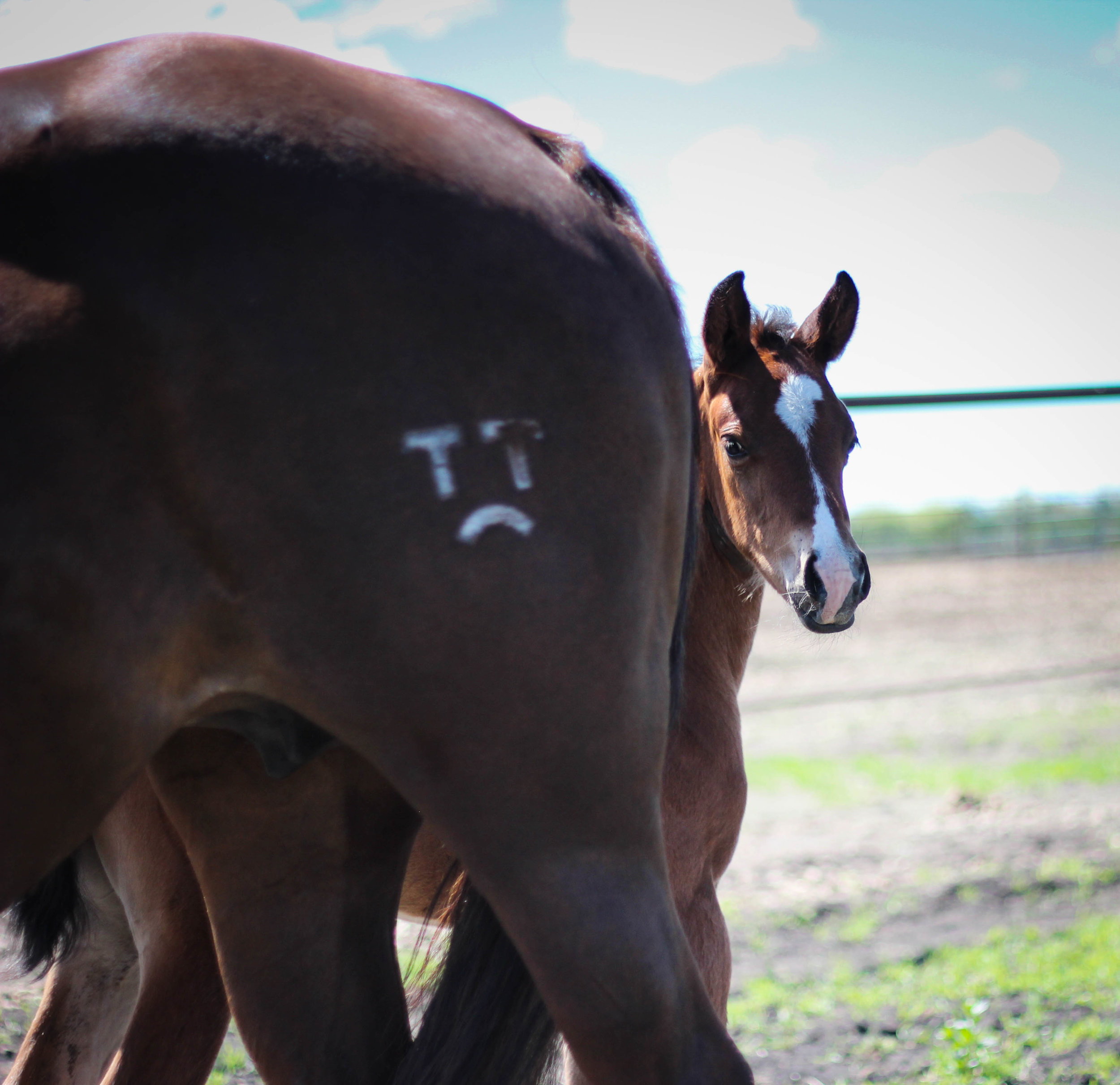Horse pregnancy signs, stages, and care for a pregnant mare include indicators such as the mare removing herself from the herd, more frequent rests, increased respiration, and kicking or looking at their abdomen. The first stage of labor can last several hours, and it is important to monitor the mare during this time.
Additionally, signs that foaling is approaching include a swollen abdomen and enlarged udder. To care for a pregnant mare, it is recommended to keep them in small groups with others at a similar stage of pregnancy and separate them from outside mares.
Signs Of Horse Pregnancy
During horse pregnancy, signs such as a mare removing herself from the herd, more frequent rests, pacing, running milk from the udder, increased respiration, and kicking or looking at their abdomen may indicate that the foal is preparing to be born.
It is important to be aware of these signs and provide the necessary care for a pregnant mare.
Moody Mares
A pregnant mare may exhibit changes in behavior due to hormonal fluctuations. One of the most common signs of horse pregnancy is moodiness or irritability. The mare may become more sensitive, easily agitated, or display unpredictable mood swings. These changes are caused by the increased levels of progesterone and other hormones in her body.
During this time, it is important to approach the mare with caution and understanding. Give her space and avoid sudden movements or loud noises that could startle her. Providing a calm and consistent environment will help her feel more at ease during this stage of her pregnancy.
Heat Rising
Another sign of horse pregnancy is an increase in body temperature. As the pregnancy progresses, you may notice that the mare’s body temperature is slightly elevated compared to her normal range. This is due to the metabolic changes happening in her body as it supports the growing fetus.
It is important to monitor the mare’s body temperature regularly to ensure that it stays within a healthy range. If you notice a significant increase or if her temperature reaches above the normal range, it is advisable to consult with a veterinarian to rule out any potential issues.
Tell-tale Tummy
One of the most obvious signs of horse pregnancy is a growing abdomen. As the fetus develops and grows, the mare’s belly will gradually expand, becoming more rounded in shape. This is often referred to as “bagging up.”
Keep in mind that not all mares will show a significant belly enlargement, especially in the early stages of pregnancy. However, as the pregnancy progresses, the change in the mare’s body shape will become more apparent.
Regularly monitoring the size of the mare’s abdomen can help you track the progress of her pregnancy. It is also important to adjust her diet and exercise routine accordingly to support her changing body and the needs of the developing foal.

Credit: www.burwashequine.ca
Stages Of Horse Pregnancy
Understanding the stages of horse pregnancy is crucial for the proper care and management of a pregnant mare. Horse pregnancy is divided into three trimesters, each with its own set of changes and developments. From the initial signs of pregnancy to the final weeks leading up to foaling, here is a breakdown of the different stages:
First Trimester
The first trimester of horse pregnancy is a critical time for the developing embryo. It begins with fertilization and implantation, which usually occurs around 14 to 16 days after breeding. During this period, the embryo will undergo rapid cell division and organ formation.
Some key signs of pregnancy in the first trimester include:
- Absence of heat cycles
- Changes in appetite and behavior
- Gradual weight gain
- Muscle relaxation and softening of the cervix
It’s important to provide the pregnant mare with a balanced diet and regular veterinary care during this stage to ensure proper fetal development.
Second Trimester
The second trimester spans from approximately 40 to 120 days of gestation. By this stage, the fetus has already taken on a recognizable equine form. The major organs and systems continue to develop, and the fetus begins to grow rapidly in size.
Signs and changes to expect during the second trimester include:
- Increased weight gain
- Visible growth of the abdomen and udders
- A noticeable increase in fetal movement
- Changes in the mare’s overall body shape
During the second trimester, it’s crucial to ensure the pregnant mare receives proper nutrition, exercise, and regular check-ups to monitor the health of both the mare and the developing foal.
Third Trimester
The third trimester is the final stage of horse pregnancy, typically spanning from around 240 to 330 days of gestation. During this period, the fetus grows significantly in size and continues to develop important body systems.
Signs of the third trimester may include:
- A further increase in weight gain
- Further growth of the abdomen and udders
- Colostrum production in the udders
- Relaxation of the pelvic ligaments in preparation for foaling
In the last few weeks leading up to foaling, it’s crucial to closely monitor the mare for any signs of imminent labor and ensure the foaling environment is safe and prepared.
Caring For A Pregnant Mare
Monitoring The Mare’s Health
During a mare’s pregnancy, it is crucial to closely monitor her health to ensure a successful and uncomplicated foaling process. Regular check-ups with a veterinarian will help in identifying any potential problems or complications early on. Keep a close eye on the mare’s weight, as excessive weight gain can lead to difficulties during labor. Additionally, monitor her overall well-being by observing her behavior and appetite. Any sudden changes in behavior or appetite should be reported to the vet immediately.
Providing Adequate Nutrition
Proper nutrition is essential for maintaining the health and well-being of a pregnant mare. Make sure the mare’s diet is well-balanced and provides all the necessary nutrients for her and the growing foal. A diet rich in high-quality hay or pasture, along with a suitable concentrate feed, can meet her nutritional requirements. Consult with a veterinarian or equine nutritionist to design a feeding plan that meets the specific needs of the pregnant mare. It is also important to provide access to clean, fresh water at all times.
Creating A Suitable Environment
The environment in which a pregnant mare is housed plays a crucial role in her overall well-being and comfort. Provide a spacious and well-ventilated stall or paddock that allows the mare to move comfortably. Bedding should be clean, free of dust, and regularly changed to maintain hygiene. Avoid placing the mare near any potential sources of stress or disturbance, such as loud noises or aggressive horses. Regular exercise, under the guidance of a veterinarian, can also help keep the mare’s muscles toned and promote overall health.

Credit: 3hvet.com
:strip_icc()/pregnancy-in-horses-1885935_FINAL-5bb7bb4c46e0fb0026de573e.png)
Credit: www.thesprucepets.com
Frequently Asked Questions On Horse Pregnancy: Signs, Stages, And How To Care For A Pregnant Mare
What Care Does A Pregnant Mare Need?
During pregnancy, a mare needs to be separated from other mares, kept in small groups with similar stages of pregnancy, and isolated from outside mares. It’s important to provide proper nutrition and monitor for signs of foaling, such as a swollen abdomen and enlarged udder.
How Do You Deal With A Pregnant Mare?
To deal with a pregnant mare, keep her in a small group with similar pregnant mares. Separate long-term resident mares from outside mares. Ensure she gets proper nutrition and monitor her for signs of foaling, such as a swollen abdomen and enlarged udder.
How Do You Know When A Mare Is Ready To Give Birth?
A mare is ready to give birth when she exhibits these signs: separating from the herd, resting more frequently, pacing, milk running from the udder, increased respiration, kicking or looking at her abdomen, holding her tail up, and excessive grazing.
How Do You Know When A Mare Is Close To Foaling?
A mare is close to foaling when she removes herself from the herd, rests more frequently, paces, runs milk from her udder, has increased respiration, kicks or looks at her abdomen, holds her tail up, and grazes excessively. These are indicators that she is preparing to give birth.
Conclusion
Caring for a pregnant mare is crucial for the health of both the mare and the upcoming foal. From closely monitoring the signs and stages of pregnancy to providing proper nutrition and a comfortable environment, every step plays a vital role in ensuring a successful and healthy pregnancy.
By understanding the signs and stages of horse pregnancy and following the right care practices, you can contribute to the well-being of your pregnant mare and increase the chances of a smooth foaling process and a healthy foal.

